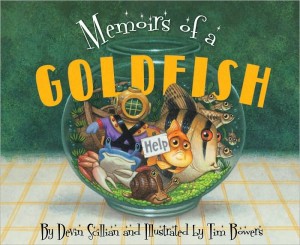Sometimes, Sherry and I are accidentally brilliant. This book was one such moment for us. While perusing Amazon for some fun, new picture books to use with primary students, we came upon Memoirs of a Goldfish. Immediately we began to smile. With such a perfect title, we couldn’t pass it up. What could a goldfish possibly have to say? What would be in his memoir? We bought it and waited eagerly for it to arrive.
Why I finished it
Turns out – this book is a perfect mentor text for personal narratives! It was fast-paced, engaging, and funny. It was almost sad when it ended. “Day one – I swam around my bowl.” Perfection! We also got a pleasant surprise in that it has a sweet message about friendship as well. We loved it, but we needed a kid perspective, so I read this book to a class of eager Kindergarten students. They interacted with each page and each student was engaged from beginning to end. As a class we made predictions and discussed how the goldfish was feeling. They are waiting for me to return with the sequel, Memoirs of a Hamster.
Who I would give it to
Any elementary teacher. It is a great book for read aloud, discussing personal narratives and memoirs, making predictions, and theme! I must admit, hope friends aren’t reading this blog post, because I love giving this book as a gift!
Integration Ideas
Writing a Memoir
A memoir is similar to an autobiography, but only about a small moment or portion of life. Students can practice zooming in on a small moment of their life. What is the moral? What did you learn from this experience? Pay attention to the mentor text, sometimes a day only has one sentence and other times there are many with reflective comments. Have students begin to write their own memoir. (Not much different from the expectations for writing personal narratives).
Morals and Themes
Help students see the message behind the fun story. What did the goldfish learn? How did this story impact his life? Have students write the theme with text evidence that helps support the theme. Don’t forget to create an anchor chart.
Predicting and Making Inferences
While reading the story aloud, stop every so often to question how the students think the fish is feeling. This book’s word choice and well crafted drawings provide a lot of information to how the fish is feeling. Students can use the text evidence (text and pictures) as well as their background knowledge to decide how Mr. Bubbles is feeling.







Leave a Reply